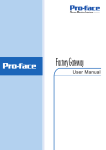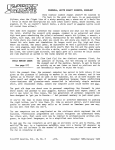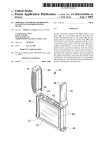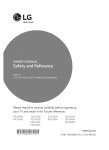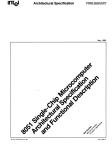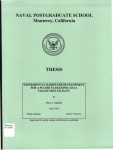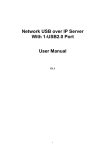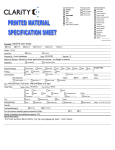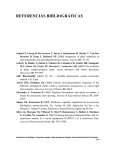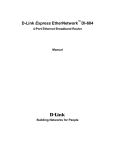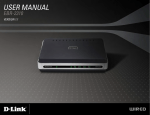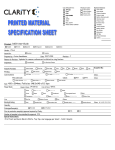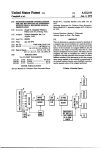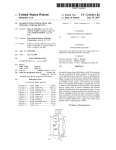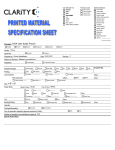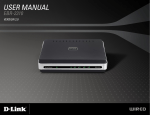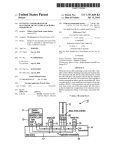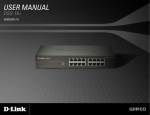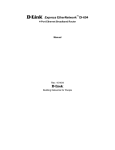Download Sewer X
Transcript
US007644211B2 (12) Unlted States Patent (10) Patent N0.2 Toebes et a]. (54) (45) Date of Patent: Jan. 5, 2010 METHOD AND SYSTEM FOR 5,586,033 A * CONTROLLING TRANSMISSION OF USB 5,655,151 MESSAGES ()VERA DATA NETWORK BETWEENA USB DEVICE ANDA 5,719,961 A * 5,784,393 A * 2/1998 Normile et al. 7/1998 Byers et al. 6,061,746 5/2000 PLURALITY 0F HOST COMPUTERS (75) US 7,644,211 B2 A A 12/1996 Hall .......................... .. 701/50 * 8/1997 * BoWes et a1. . . . . . . Stanley et al. . . . . . . . . .. 710/22 382/239 714/800 . . . .. 710/10 6,141,719 A * 10/2000 Rafferty et al. 710/316 6,182,167 B1* 1/2001 Basham et al. 710/38 6,308,239 B1 * 10/2001 Osakada etal. ........... .. 710/316 Inventors: John Toebes, Cary’ NC (Us); Arthur HoWarth, San Jose, CA (US); Mickey Sartin, Apex, NC (US) 73 (Continued) OTHER PUBLICATIONS Assi gnee: Cisco Technolo gy, Inc., San Jose, CA (Us) Compaq et a1. Universal Serial Bus Speci?cation. Apr. 27, 2000. Revision 2.0.* * Notice: Sub'ect to any disclaimer, the term of this J (Continued) patent is extended or adjusted under 35 U.S.C. 154(b) by 162 days. Primary ExamineriMark Rinehart Assistant ExamineriMattheW D Spittle (74) Attorney, Agent, or FirmiWeaver Austin Villeneuve (21) Appl.No.: 11/006,989 (22) Filed: (65) (52) (57) Prior Publication Data US 2006/0123166 A1 (51) Austin LLP Dec. 7, 2004 Int. Cl. G06F 13/42 Jun. 8, 2006 A solution is provided for controlling universal serial bus (U SB) messages betWeen a plurality of host computers and a USB device. First and second USB servers may communicate (2006.01) With ?rst and second host computers, respectively. A USB US. Cl. ..................... .. 710/106; 710/305; 710/306; client may then communicate With the USB device. A ?rst control path betWeen the USB client and the ?rst USB server and a second control path betWeen the USB client and the 710/308; 370/402; 370/466 (58) ABSTRACT Field of Classi?cation Search ............... .. 710/200, 710/315, 37, 305, 241, 1064108, 316; 370/254, second USB server may be established. Then a ?rst data 370/402, 466, 474 See application ?le for complete search history. transfer path may be established betWeen the USB client and the ?rst USB server, the ?rst data transfer path enabling the sending of data betWeen the USB client and the ?rst USB (56) References Cited server over a data network. Then a busy message may be sent from the USB client to the second USB server over the second U.S. PATENT DOCUMENTS control path When the ?rst data transfer path is established 4,135,240 A * 1/1979 Ritchie ..................... .. 711/164 4,835,737 A * 5/1989 Herrig et a1. . 5,408,627 * 4/1995 Stirketal. 5,416,910 A * 5/1995 Moyer etal. .............. .. 710/113 A ...... 710/302 . . . .. With the ?rst USB server. 711/151 35 Claims, 12 Drawing Sheets 100 E MASTER SLAVES Ethernet M 140a use I 12 -/\ 135 12D 130 5 Client 14Gb 105_/_\ USB Sewer X USB USB Client |p Network 145 5 1400 110 USB Big, use Client Device 140d USB Client US 7,644,211 B2 Page 2 PCI Special Interest Group. PCI Local Bus Speci?cation. Jun. 1, US. PATENT DOCUMENTS 6,334,121 B1 * 6,369,909 B1* 12/2001 4/2002 PrimeauX et al. ............ .. 706/62 Shima ......... .. 358/1.15 1995.* Inside Out Networks. AnywhereUSB. Product Data Sheet. 2005.* Greenberg et a1. IP-Over-USB Gateway. Final Project Report. Apr. 15, 2005* 6,381,666 B1* 6,389,029 B1* 4/2002 Kejser et al. 5/2002 McAlear 710/300 370/402 6,546,450 B1* 4/2003 710/316 Storage Adapter. datasheet. 2005.* 6,549,966 B1 * 4/2003 Dickens et al. . 710/300 SIIG Inc. USB Over IP. User’s Manual. Jun. 2008.* 6,600,739 B1 * 7/2003 Evans et al. 370/362 Digi 5 -Port USB Any Where Remote USB Over IP Extender, KVMs. 6,904,489 B2 * 6/2005 710/315 corn web page http://www.kvms.con1/nav/item.asp?item:8221, 6,934,793 B2 * 8/2005 Ying et al. .. 710/316 7,047,344 B2 * 5/2006 Lou et al. 710/305 7,069,373 B2 * 7,412,621 B2* 6/2006 8/2008 710/310 714/10 printed Oct. 14, 2004. Inside Out Networksithe Leader in Enterprise USB Connectivity Products, Inside Out Networks web page http://www.ionetworks. con1/products/indeX.jsp, printed Oct. 14, 2004. Liu ....... .. Zarns .... .. Teng ..... .. Choi .............. .. D-Link. DNS-120. Express EtherNetwork USB to Ethernet Network 2003/0074431 A1 * 4/2003 AbbondanZio et al. 709/221 USB Over IP.‘ Turning Your Network Into an I/O Bus, White Paper, 2004/0095888 A1* 5/2004 Noel, Jr. ................... .. 370/238 www.ionetworks.com, © 2003-2004 Digi International Inc. 91001239 A1/0204, 3 pages. AnyWhereUSB®, Inside Out Networksithe Leader in Enterprise USB Connectivity Products web page http://www.ionetworkscom/ 2005/0027889 A1* 2/2005 Sandulescu . . 709/250 2005/0135422 A1* 6/2005 Yeh ............. .. . 370/474 2005/0265385 A1* 12/2005 Cromer et al. 2006/0069543 A1* 2006/0123129 A1 370/466 3/2006 Sajwani et a1. .... . . . . .. 703/24 6/2006 Toebes et al. ............. .. 709/230 OTHER PUBLICATIONS Byard, Larry F. DuX Computer Works. FAQs: Mac Address. Feb. 2, 2002. http://www.duXcw.con1/faq/network/mac .htrn.* products/usboverip/indeXjsp, printed Oct. 14, 2004. MIMIO by I/lrtual Ink, Copyright © 2004, Virtual Ink Corporation web page http://www.min1io.con1/, printed Oct. 14, 2004. USPTO Of?ce Action issued in related U.S. Appl. No. 11/006,988 dated Jun. 12, 2008 (22 pages). * cited by examiner US. Patent Jan. 5, 2010 Sheet 1 0112 o: poi. moi \mm: US 7,644,211 B2 m : 8.50 to: m : E26 Em=0 mwD Em=0 652m N mhwiz mwD mm? W .GEF m : 62m mwD (1 mg US. Patent Jan. 5, 2010 Sheet 2 0112 i US 7,644,211 B2 105 8 120 USB @ERVERLAN A /205 FIG. 2 115 A0 m; 305 LAN USB Client 140C FIG. 3 USB Device US. Patent Jan. 5, 2010 Sheet 3 0112 US 7,644,211 B2 /120 USB Server “[330 USB Interface Module 425 |p |nterface Module 335 Translation Module N Association Module “5540 List USB Client Association Established? ~45 140a 14Gb 1400 140d FIG. 4A X x x US. Patent Jan. 5, 2010 Sheet 4 0112 US 7,644,211 B2 USB Ciient ’___/350 ‘P Interface Module R355 USB Host Modme 360 Translation Module ~ Association Module “i565 FIG. 4B 370 i\"(bio- US. Patent Jan. 5, 2010 Sheet 5 0112 US 7,644,211 B2 A6400 Receive USB Message A’ 405 Translate USB Message to /-\__ 410 Network Message Send Network Message /\—- 415 500 Receive Network Message i Translate Network Message to USB Message i Provide USB Message FIG. 5B /\ 515 US. Patent Jan. 5, 2010 Sheet 6 0112 US 7,644,211 B2 m : m2>w0 o: on: A m : Em=0 000 @.OE m: Ewe: moo f m : m62m mo? om? f mwD 62%< m5 05 f m : 062m 0mm US. Patent Jan. 5, 2010 0 3‘ Sheet 7 0112 US 7,644,211 B2 m : E26 A 0 M. .GEN v6< % o _ m 5 N 6<2E5m6cma; 9E0mcm?|Y(\1A % mwDown 659mm05960(\1 m : 63%m mow(\1 mwD 602m US. Patent Jan. 5, 2010 Sheet 8 0112 US 7,644,211 B2 81Q2 6:05 mmwmwwmvwK.\\ 6m2%: 52.68:vx5_0.c7O>?HwZ M‘m8‘E26> w >$2/56=n_o>:_ K16:.0w2m3?6:0w‘m? o8m8\ \=E5m8o3:2m 9%mE2:6 m6n0o@C: ON?\ >>w222$mm:\1 > r / m58m0% 83\ 2%8w0% UmE0:53 \ v.tO25m@>0B3®:Z0 ‘mLIoQvtHuGrzU< 8.50 ,/ F US. Patent Jan. 5, 2010 Sheet 9 0112 US 7,644,211 B2 com “$m1-2 : E=823o m6&I. ImDhmw A O;x Ema 6HwoI vc5oimnz< “we: ESQ A’ A Eiaow 0%& 08\ A .QEm US. Patent Jan. 5, 2010 Sheet 12 0f 12 US 7,644,211 B2 0: E052 @$92405 0250 muEQ O E32 5 $523:0 E3805 om: ow: m: m: mw: .QI:. cm: 59: $250 m: $52G 0: m: om: US 7,644,211 B2 1 2 METHOD AND SYSTEM FOR CONTROLLING TRANSMISSION OF USB MESSAGES OVER A DATA NETWORK BETWEEN A USB DEVICE AND A PLURALITY OF HOST COMPUTERS on the order of several meters. With USB hubs, USB devices can be connected to a host computer up to about 30 meters aWay from the host. HoWever, the distance betWeen the USB device and the host it communicates With is still limited to the physical distance of the USB cables and hubs. Because of the physical limitation of the USB cable, attempts to connect USB devices remotely With respect to a host have been problematic. One example of a USB device CROSS-REFERENCE TO RELATED APPLICATION Which has not been effectively connected to the host as a remote device is a USB-enabled multi-function printer. Print The present application relates to commonly assigned, copending US. Patent Application, ?led concurrently here servers exist that use an LPR protocol and provide an Ethernet With, for METHOD AND SYSTEM FOR SENDING AND RECEIVING USB MESSAGES OVER A DATA NET WORK Ser. No. 11/006,988. The disclosure of the above connection to the printer. HoWever, many print servers pre clude the bi-directional protocol of the multi-function printer. The print server only provides the print function of the printer and eliminates the enhanced functions of the printer. Also, When the host computer is connected by virtual private net Work (VPN) in a corporate environment, the Ethernet enabled printer is not available to print from the host computer. In the listed application is incorporated herein by reference in its entirety for all purposes. BACKGROUND OF THE INVENTION 1. Field of the Invention The present invention relates generally to transmission of 20 past, the only Way to access the multiple functions of the printer Was to disconnect the printer from the VPN and con nect the printer to the host computer by a USB cable. Then, to USB messages. More particularly, the present invention access the printer via the VPN, the printer had to be discon relates to controlling the transmission ofUSB messages over a data netWork betWeen a USB device and a plurality of host nected from USB and re-connected to the VPN. computers. With the advent of multiple hosts, it is desirable to share 25 2. Description of the Related Art Universal Serial Bus (“USB”) has become a standard for hosts. Conventional techniques for connecting USB devices connecting peripherals to computers. Most computers have USB ports alloWing the connection of USB-enabled periph erals such as mice, keyboards, printers, scanners, digital cam 30 eras, Webcams, modems, speakers, telephones, storage devices, ?ash card readers, network interfaces, and other devices. One bene?t of USB is that any USB-enabled device 35 Regardless of the particular USB device, the USB device can be plugged into the host computer simply by connecting a USB cable betWeen the device and the host computer. When the USB device is connected, the operating system of the host computer can often automatically detect it. Driver softWare to hosts have only provided for one-to-one connections: one USB device to one host. Logical sharing of USB devices among tWo or more hosts has not been possible. The only Way to arguably share a USB device has been is in the physical senseithe USB cable connecting the USB device to a ?rst host is physically unplugged from the ?rst host, moved into the necessary proximity With a second host, and then plugged (“USB device”) can be connected to its host computer using the same, standardized USB connection. common peripherals. HoWever, an additional limitation of USB is the inability to share USB devices among tWo or more into the second host. What is needed is a scheme for eliminating the physical distance limitation of USB, enabling the remote connection and communication of a USB device With a ho st, and enabling the sharing of a USB device or devices by multiple hosts. 40 can be easily installed on the host computer to interact With the USB device. SUMMARY OF THE INVENTION For host computers With feWer USB ports than desired USB devices, a USB hub can be connected to provide addi tional USB connections. Conventional USB hubs, such as a Aspects of the present invention relate to methods, com 45 4-port hub, can be plugged into the USB port on the host computer, enabling the connection of 4 USB devices to the single USB host port. USB hubs can be chained together to provide additional USB ports as desired and share the band Width available on the root port. There are generally four types or modes of data transfer that can occur betWeen the USB device and the computer: (1) messages betWeen a plurality of host computers and a USB device over a data netWork. A ?rst USB server is in commu 50 55 60 path When the data transfer path is established With the ?rst device such as a mouse or keyboard that sends data at a loWer bandWidth and speed. Bulk mode is used for devices such as printers Which receive data in larger packets. In one example, a block of data is sent to the printer in 64-byte packets. Isochronous mode is used for streaming devices such as speakers. Data streams betWeen the USB device and the com USB client to the second USB server over the second control USB server. puter. A USB cable connects a USB device and host computer in a point-to-point manner. The USB cable limits the physical distance and connectivity betWeen a USB device and the ho st. Individual USB cables are generally manufactured in lengths nication With a ?rst one of the host computers and the data netWork. A second USB server is in communication With a second one of the host computers and the data netWork. A USB client is in communication With the data netWork and the USB device. A ?rst control path is established betWeen the USB client and the ?rst USB server, and a second control path is established betWeen the USB client and the second USB server. A data transfer path is established betWeen the USB client and the ?rst USB server. The data transfer path enables sending of data betWeen the USB client and the ?rst USB server over the data netWork. A busy message is sent from the Control, (2) Interrupt, (3) Bulk and (4) Isochronous. Control mode is used to enumerate (identify) a device and is often used for out of band device control such as accessing control registers on the device. Interrupt mode can be used for a puter program products, apparatus, and systems for control ling sending and receiving of universal serial bus (“USB”) BRIEF DESCRIPTION OF THE DRAWINGS 65 FIG. 1 shoWs a block diagram of a system 100 for sending and receiving Universal serial bus (“USB”) messages betWeen a host computer and a USB device over a data net US 7,644,211 B2 3 4 work, where the USB server is an external device, according implementations, bulky or seldom used USB devices can be to one embodiment of the present invention. FIG. 2 shows an illustration of a host computer 105 in which a USB server is situated, according to one embodiment physically located in designated areas, and connected of the present invention. changeably herein, generally referring to a computer or other data processing apparatus capable of interacting with a USB server using the methods and apparatus described below. FIG. 1 shows a system 100 for sending and receiving USB remotely to one or more host computers over the data net work. The terms “host computer” and “host” are used inter FIG. 3 shows an illustration of a USB device 110 in which a USB client is situated, according to one embodiment of the present invention. FIG. 4A shows a block diagram of a USB server 120, in accordance with one embodiment of the present invention. FIG. 4B shows a block diagram of a USB client, in accor dance with one embodiment of the present invention. FIG. 5A shows a ?ow diagram of a method 400 performed messages between a host, in this case computer 105, and a USB device 110 over a data network 115, according to one embodiment of the present invention. In the system 100 of FIG. 1, the host computer 105 can be a personal computer, workstation or any other data processing apparatus, depend ing on the desired implementation. The USB device 110 is any device such as a peripheral that communicates using the by USB server for sending a USB message over a data net work, performed in accordance with one embodiment of the USB protocol. Examples of USB device 110 include printers, scanners, mice, keyboards, cameras, webcams, multifunction printers, ?ashcard readers, hard drives, ?ash drives, and vari present invention. FIG. 5B shows a ?ow diagram of a method 500 for trans lating and communicating a network message as a USB mes sage for a connected computer or USB device, performed in accordance with one embodiment of the present invention. 20 FIG. 6 shows a block diagram 600 ofa plurality of USB between elements connected to the data network 115 at net work addresses on the data network 115. Examples of data Servers capable of interfacing with a USB client over a data network, according to one embodiment of the present inven tion. FIG. 7 shows a block diagram 700 ofa plurality of USB network 115 include any wired network, wireless network, layer 1, layer 2, layer 3 networks, the Internet, an intranet, an 25 network, according to one embodiment of the present inven tion. computer and a USB device over a data network, according to one embodiment of the present invention. FIGS. 10A and 10B show a ?ow diagram ofa method 1000 In FIG. 1, system 100 further includes a USB server 120 in 30 35 communication with host computer 105 and data network 115. The USB server 120 provides translation of messages in a USB protocol to and from network messages, that is, mes sages formatted in a suitable network protocol for passing over data network 115. In one embodiment, as shown in FIG. 1, USB server 120 includes two physical connections. The USB server 120 connects to host computer 105 through a USB port 125 in or connected to the host computer 105. The USB port 125 is a conventional USB port which interacts with conventional USB driver software in the host computer 105. for controlling the sending and receiving of USB messages between a plurality of host computers and a USB device over a data network, according to one embodiment of the present extranet, local area network (“LAN”), wide area network (“WAN”), and any combination thereof. Servers capable of interfacing with a USB client over a data FIG. 8 shows a block diagram of apparatus 800 for con trolling sending and receiving of USB messages over a data network, according to one embodiment of the present inven tion. FIG. 9 shows ?ow diagram of a method 900 for controlling the sending and receiving of USB messages between a host ous media players. In FIG. 1, the data network 115 is any network or combination of networks capable of passing data The USB server 120 and host computer 105 send USB mes 40 invention. FIG. 11 shows a block diagram of a data processing appa ratus 1100 such as host computer 105, used in accordance with embodiments of the present invention. sages, that is, messages formatted in the USB protocol, between one another through USB port 125. A second physi cal connection of USB server 120 is a network connection 130 for sending network messages to and from data network 115. In one embodiment, as shown in FIG. 1, the network connection 130 provides an internet protocol (“IP”) endpoint 45 or node for USB server 120 on data network 115. In one DETAILED DESCRIPTION OF THE INVENTION example, as shown in FIG. 1, the network connection 130 includes an Ethernet port which interfaces with Ethernet 135. Embodiments of the present invention enables remote con nectivity of USB devices to a host computer or other data For purposes of illustration, in FIG. 1, Ethernet 135 is shown separate from data network 115. Those skilled in the art will appreciate that Ethernet 135 can be provided as part of data network 115. In FIG. 1, the system 100 includes a plurality of USB clients 140a-140d. Each USB client 140a-140d is capable of servicing an associated USB device. For instance, in FIG. 1, USB client 1400 is in communication with USB device 110. processing apparatus, regardless of the operating system on the computer, and regardless of the type of USB device (e.g., camera, printer, keyboard, ?ash card reader, media player). 50 This host computer or apparatus has full access to a plurality of USB devices served on a data network. One embodiment of methods and apparatus of the present invention provides for a 55 split software spoo?ng technique to implement a USB (“Uni Each USB client also interfaces with data network 115 over a versal Serial Bus”) system over a data network. The spoo?ng suitable network connection for communicating messages technique, described below, enables the USB system to between data network 115 and a USB device in communica tion with that USB client. USB client 140c generally has two connections: a USB connection, and a network connection 145. USB client 140c connects to USB device 110 through a USB port. USB client 140c connects to data network 115 through the network connection 145 such as an Ethernet port, similar to USB server 120. The network connection 130 for USB server 120, and the network connection 145 for USB appear to include a physical USB connection between a host computer and a USB device, when in fact the USB device is remotely connected to the host computer over the data net 60 work. Thus, the physical USB cable requirement and distance limitation associated with conventional USB cables can be eliminated. One embodiment of methods and apparatus of the present invention further provides for the sharing of hosts or host computers by a remotely connected USB device. In some 65 client 1400 can be any suitable connection, including LAN/ WAN, wireless, wired, and even powerline. USB client 140c US 7,644,211 B2 5 6 provides translation of USB messages to and from network messages and sending such messages betWeen data network 115 and USB device 110. These functions and additional hardWare to provide the functions of USB client 1400 and the necessary physical connections to data netWork 115 and USB device 110. In an alternative embodiment shoWn in FIG. 2, USB server functions of USB clients are described beloW. 120 is situated Within host computer 105. In this embodiment, In FIG. 1, using techniques described beloW, USB server USB server 120 connects to a netWork interface 205 provided 120 appears to host computer 105 as a conventional N-port USB hub. USB Server 120 emulates the interaction of the conventional USB hub With host computer 105. Conventional USB hub softWare provided on host computer 105 supports USB protocol and interacts With USB server 120 as if USB Within host computer 105 for connecting to data netWork 115. Thus, in the embodiment of FIG. 2, USB server 120 does not need its oWn external physical connection for connecting to data netWork 115. In the embodiment of FIG. 2, USB server 120 can be implemented primarily in softWare to perform the same functions provided by USB server 120 in FIG. 1. FIG. 3 shoWs an alternative implementation of USB client 1400 to that shoWn in the system 100 of FIG. 1. In FIG. 3, similar to the implementation of USB server 120 in FIG. 2, USB client 1400 is situated Within USB device 110. USB client 1400 communicates With data netWork 115 through a netWork interface 305 provided by USB device 305. Thus, as server 120 is a conventional USB hub. No additional softWare or hardWare is needed for host computer 105 to interact With USB server 120. Similarly, each USB client 140a-140d can interface With a USB device such as device 110 using a conventional USB port. The USB client 1400 appears to USB device 110 as one output or output port of a conventional USB hub. No additional softWare or hardWare is required for USB device 110 to interact With USB client 1400. In FIG. 1, the plurality of USB clients 140a-140d are associated With the single USB server 120. In another embodiment of the present invention, there are a plurality of host computers such as host computer 105, and a plurality of With USB server 120 in FIG. 2, USB client 1400 does not 20 require its oWn external physical connection to data netWork 115. USB client 1400 essentially piggybacks on the function ality provided by netWork interface 305 to interact With data netWork 115. In the embodiment of FIG. 3, USB client 1400 can be implemented primarily in softWare on the USB device 110. This softWare implementation can be bene?cial in cir USB servers such as USB server 120. Each host computer is in communication With a respective one of the USB servers. 25 There are also a plurality of USB devices, such as multi cumstances Where there are siZe and space constraints on function printers, each of Which has an associated USB client. USB client 1400. In FIGS. 2 and 3, because USB server 120 and USB client The USB servers and USB clients are connected to netWork 115 in the same manner as USB server 120 and USB client 1400, as illustrated in FIG. 1. In this embodiment, any com bination of the USB clients can be associated With any com bination of the USB servers. For example, ten printers con nected to respective USB clients can be associated With a 1400 are implemented primarily in softWare, on the respective 30 and USB client 1400 can be characteriZed as “logical” or “virtual” implementations. On the other hand, in one imple mentation of the embodiment shoWn in FIG. 1, the USB single personal computer (PC). Then a virtual unplug opera tion, that is, re-association, can be performed so that ?ve of the ten printers are associated With a ?rst PC and USB server host computer 105 and USB device 110, the USB server 120 server 120 and USB client 140d include hardWare to carry out 35 the respective functions and provide the necessary physical connections for USB server 120 and USB client 140d. In this pair, and the remaining ?ve printers are associated With a second PC and second USB server. This virtual unplug opera predominantly hardWare implementation, USB server 120 and USB client 140d can be characterized as “physical” devices. The virtual implementation is more cost effective tion can be performed dynamically so that any one of the USB clients can be re-associated With any one of the USB servers. 40 and raises the shareable bus bandWidth When the physical When such a re-association is performed, the computer 105 medium’s (e.g. Gigabit Ethernet) bandWidth is greater than the USB bus. The physical implementation provides host computer 105 operating system independence and USB client receives a “connect” and “disconnect” message from the USB server 120 as if the USB devices Were physically plugged or unplugged into the USB port 125. In one embodiment of the system 100 of FIG. 1, USB server 120 generally does not need a poWer supply indepen 140d compatibility to various USB devices. 45 dent of that provided by USB port 125. That is, the host computer 105 can poWer USB server 120 through the USB port 125. In one embodiment, as the host computer 105 is poWering the USB server, the ho st computer 1 05 Will limit the poWer it serves through the USB server to the USB devices 50 provides an IP address for USB server 120 so that USB server 120 can send and receive messages as IP packets or other (100 mA). In another embodiment, the USB server is self poWered alloWing the USB Device 110 the full amount of poWer available on a hub port (500 mA). In a third embodi ment, the USB server manipulates the USB device 110’s 55 poWer requirement messages to state the device is fully self poWered and needs no poWer through the bus. Embodiments of the present invention provide for different implementations of USB server 120 and USB clients such as USB client 1400. In one embodiment, as shoWn in FIG. 1, USB server 120 is external to host computer 105. In this embodiment, USB server 120 includes softWare con?gured to formats suitable for sending over data netWork 115. The IP connection established betWeen IP interface module 325 and data netWork 115 can be established With any suitable form of Wired or Wireless IP connectivity such as RG-45, poWer line, 802.11 in all forms, and conventional Ethernet connectivity. Secondly, in FIG. 4A, USB server 120 further includes a USB interface module 330 Which interfaces and interacts 60 With host computer 105 through USB port 125, providing the USB hub emulation described above. USB interface module 330 is con?gured to implement the appropriate USB hub provide the functions described beloW, and hardWare needed to carry out these functions and to provide physical connec tions to host computer 105 and data netWork 115. Similarly, in the embodiment shoWn in FIG. 1, USB client 1400 is situated external to USB device 110 and incorporates softWare and FIG. 4A shoWs a block diagram of a USB server 120, in accordance With one embodiment of the present invention. The USB server 120 includes apparatus to generally perform at least four functions. First, the USB server 120 includes an IP interface module 325 Which enables USB server 120 to be an IP client of data netWork 115. The IP interface module 325 65 device protocol capabilities. The third function of USB server 120 is a implemented in a translation module 335 Which, in one embodiment, provides USB over IP protocol. The trans lation module 335 is generally con?gured to translate USB messages to netWork messages (e. g., IP packets) for sending US 7,644,211 B2 7 8 USB messages received from host computer 105 as network messages over data network 115, as explained below. Simi The system 100 of FIG. 1 provides for sending and receiv ing USB messages between host computer 105 and USB larly, translation module 335 is con?gured to translate net devices such as USB device 110. The USB server 120 and work messages received from data network 115 to USB for USB client 140c cooperate to translate messages between USB protocol or format and a network format suitable for sending over data network 115. The USB server 120 and USB client 1401) provide for receiving a USB message at USB client 1400 from USB device 110, translating the USB mes sage to packets formatted for sending over the data network 115, that is, a network message. The USB server 120 receives the network message and translates the message back to the original USB format and provides the USB message to host computer 105 over USB port 125. These functionalities of mat for delivery to host computer 105 through USB port 125. Fourth, in FIG. 4A, the USB server 120 includes an asso ciation module 340 con?gured to establish and maintain an association between the USB server 120 and Zero or more USB clients. Association module 340 can establish the asso ciations using a table, TCP sockets, a web interface provided to a user of host computer 105 allowing the user to select clients to associate with, and other techniques. In one embodiment, association module 340 manages the associa tions between the USB server 120 and corresponding USB USB client 1400 and USB server 120 are reversed when host computer 105 sends a USB message to USB device 110 over clients in the form of a list 345 stored in memory or a proces sor readable storage medium accessible by association mod ule 340. The associations can be established during power-on, using data stored in ?ash memory, dynamically by discovery mechanisms to identify USB servers on the network 115, using con?gurations managed by the user, using a token 20 scheme, or with any other mechanism using an agreed-upon sequence of events. FIG. 4B shows a block diagram of a USB client, in accor dance with one embodiment of the present invention. The USB client has similar functionality as USB server 120. For instance, the USB client includes an IP interface module 350, providing the same functionality that IP interface module 325 provides for USB server 120. A USB host module 355 inter faces and interacts with a USB device 110, using USB pro tocol. The USB host module 355 implements the “host” side of USB protocol. Thus, the USB host module 355 can recog niZe USB devices when those devices are connected to the USB client. The USB host module 355 can send interrogation messages to the USB device to determine attributes of the USB device. Then the USB host module 355 will con?gure and enable the USB device 110. In FIG. 4B, the USB client further includes a translation module 360, similar to translation module 335 in USB server 120. Here, the translation module 360 is con?gured to trans late USB messages to network messages (e. g., IP packets) for sending USB messages received from USB device 110 as network messages over data network 115, and translate net work messages received from data network 115 to USB for mat for delivery to USB device 110. In addition, the USB client includes an association module 365 which is generally over data network 115. In FIG. 5A, a USB message is received from the host computer 105 or USB device 110. “USB message” generally 25 refers to a message in the USB protocol. When the USB message is received by the USB server 120 or USB client 1400, in Step 410, the server 120 or client 140c translates the USB message to a network message, that is, a message in a suitable protocol or format for sending over data network 115. 30 Suitable protocols for the network message include layer 2, layer 3, layer 4 and the other protocols appropriate for pas sing the network message over any of the implementations of data network 115 described above. In one embodiment, the USB message, a layer 2 protocol, is encapsulated in an appropriate 35 server 120 or USB client 140c sends the network message over data network 115 to the USB client 1400 or USB server 40 45 described above in FIG. 5A, the network message is essen 50 computer 105 or USB device 110 over a USB port or connec selection of the USB server, and (4) hardware settings allow tion, and properly interpreted by the receiving device. ing a user to choose the USB server. FIG. 6 shows a block diagram of USB server 120 and USB 55 60 instructions executable to perform the functions above. Simi larly, the USB client can also have a processor and memory implementations of the USB server 120 and USB client are possible, as will be understood by those skilled in the art. client 1400 in communication with data network 115, accord ing to one embodiment of the present invention. In addition, system 600 includes USB server 605 connected between data network 115 and a second host computer 615, and USB server 610 connected between data network 115 and a third host the USB server 120 includes a processor and a memory with for performing its functions. Other hardware and software tially de-encapsulated back to its original USB protocol. In Step 515, the USB message can then be provided to the host USB server, (3) a web page or other user interface allowing Those skilled in the art will appreciate that the apparatus, modules and functions described above can be implemented with combinations of hardware and software. In one example, 120. FIG. 5B shows a method 500 performed by USB server 120 or USB client 1400 for communicating a network message received over data network 115 to host computer 105 or USB device 110 as a USB message. In Step 505, when the network message is received from data network 115, the USB server 120 or USB client 140c translates the network message back to the USB format. Because the original USB message was encapsulated in the appropriate network protocol, as module 365 can select the USB server to associate with using In one embodiment, as shown in FIG. 4B, the USB client also includes a power supply 370 which can supply power to the connected USB device. In an alternative embodiment, the USB client does not include power supply 370. higher layer protocol, such as layer 3 or layer 4, during the translation step 410. Such an encapsulation operation is gen erally known to those skilled in the art. In Step 415, the USB con?gured to establish an association with Zero or one USB server at a time, such as USB server 120. The association any number of methods, including: (1) broadcast to ?nd the nearest USB server, (2) stored data identifying a particular data network 115. FIG. 5A shows a method 400 performed by USB server 120 when sending a USB message from host computer 105 to USB client 1400 over data network 115. The method 400 is also performed by USB client 1400 for sending a USB mes sage originating from USB device 110 to USB server 120 65 computer 620. In the embodiment shown in FIG. 6, USB client 1400 is capable of servicing the various USB servers 120, 605, 610. In one embodiment, USB client 140c generally maintains a one-to-one relationship with its corresponding USB server. For instance, in FIG. 1, USB client 1400 has a one-to-one relationship with USB server 120. That is, the USB client 140c associates with the single USB server 120 and establishes a connection therewith to send encapsulated US 7,644,211 B2 10 USB messages between the USB client 1400 and USB server 120 over data network 115. In the embodiment of FIG. 6, USB client 1400 can associate with the multiple USB servers with one of the USB servers, in FIG. 7, USB server 120, the other USB servers 605, 610 must generally wait until USB 120, 605, 610, although USB client 1400 generally transfers data to the servers one-at-a-time, as explained below. In the system 600, the various USB servers 120, 605, 610 can func lishes a data transfer path with one of the other servers 120, 610. FIG. 8 shows a block diagram 800 of a system for control tion as multiple hosts for the single USB client 1400. Methods and apparatus provided in USB client 1400 provide the capa ling sending and receiving of USB messages over data net work 115, using USB server 120 and USB client 1400. The bility of serving multiple hosts, as explained below. USB server 120 is associated with a host computer such as FIG. 7 shows a block diagram of a system 700 in which communications paths are established between USB client 1400 and the various USB servers over data network 115. In host computer 105 of FIG. 1. The USB client 1400 is associ ated with a USB device 110, as shown in FIG. 1. In FIG. 8, client 1400 terminates data transfer path 720 and then estab USB server 120 includes a client SW 805 an USB system SW one embodiment, the communications paths include control paths 705, 710, 715 established between USB client 1400 and the respective USB servers 120, 605, 610. The communica tions paths further include a data transfer path 720 which can 810, provided as standard USB architecture. The functional ity of modules 805 and 810 and other USB architecture is described in the Universal Serial Bus Speci?cation, Revision be established between USB client 1400 and USB server 120. Data transfer paths can also be established between USB client 1400 and the other USB servers 605, 610. Those skilled entirety. in the art should appreciate that the various paths shown in 2.0, Apr. 27, 2000, incorporated herein by reference in its 20 In FIG. 8, USB server 120 includes a USB host controller 815 which interfaces with any and all USB device drivers on host computer 105 serviced by USB server 120. The USB various times during the sending and receiving of messages, as desired for the particular implementation. Generally, data host adapter 820 is con?gured to receive network messages from the data network, receive USB messages from the host computer, and translate between USB protocol and network transfer paths are established between USB client 1400 and protocol as described above in methods 400 and 500 to pass FIG. 7 can be established independent of one another, and at one USB server at a time, as explained below. Those skilled in 25 the various messages to their destinations. In one embodi the art should also appreciate that the various control paths and data transfer path shown in FIG. 7 can be combined or further divided as desired, depending on the particular imple mentation. In one embodiment, described with reference to FIG. 7, the functionalities of the various control paths and data transfer 30 path are provided by the USB protocol. Generally, using the USB protocol, network tra?ic can be segmented into three categories. The ?rst provides for USB connection and enu meration commands, such as device discovery information including information indicating whether a device is present, the type of the device, and the status of the device, e.g., connected or disconnected. The second provides for data control messages such as NACK and STALL that provide USB protocol for the connected USB device 110. In FIG. 8, a message queue 825 situated in USB server 120 interfaces with control path 710 of FIG. 7 to provide a buffer 35 for sending control messages, e.g., “ACK,” “NACK,” and “PING,” as described in the USB 2.0 speci?cation. In FIG. 8, a stream queue 830 provides a buffer and interface with data feedback to hosts such as the USB servers when a receiving 40 device such as USB client 1400 cannot receive or handle a command or other message sent to the receiving device. The third category includes data messages that contain the content sent to or from the device. Under the USB protocol, generally the data control messages on a path separate from the data ment, USB host adapter 820 is divided into a receiving part which is con?gured to receive USB messages and network messages, and a translating part con?gured to translate mes sages from one protocol to another. The USB host adapter 820 is further con?gured to send network messages over the data network to USB client 1400 for subsequent translation back to 45 transfer path 720 in FIG. 7 for streaming data such as network messages to and from data network 115 for later translation to a USB protocol for host computer 105 or USB device 110. Those skilled in the art should appreciate that different types of streaming can be set up and enabled through stream queue 830 depending on the desired type of data transfer between USB server 120 and USB client 1400 over data network 115, e.g., bulk, isochronous, etc. The stream queue 830 and mes path or data transfer path. In FIG. 7, for purposes of simpli sage queue 825 can be used to adjust for network jitter during ?cation, the control paths 705, 710, 715 provide receiving and a USB transmission. In one implementation, two separate sending of the ?rst two categories of USB messages, that is, TCP/IP sockets are provided by network connection 130 USB connection and enumeration commands, as well as data control messages such as NACK and ACK over the appropri between USB server 120 and data network 115. One TCP/IP socket is provided for message queue 825 to send data over 50 ate endpoints. The data transfer path 720 provides sending control path 710, of FIG. 7. The second TCP/IP socket is used and receiving of data such as the network messages described herein. In one embodiment, different network characteristics are applied to each of the paths. For example, a data control message can have higher network priority than bulk data grams. In FIG. 7, generally when USB client 1400 boots up or is otherwise enabled, the USB client 1400 searches for and associates with one of the USB servers 120, 605, 610. When the association is made, control messages are sent between the USB server and USB client over the control path between the two devices. Data, such as a network message containing an encapsulated USB message, is sent over data transfer path 720. The network messages are generally packetiZed in a suitable format or protocol for sending over the data network 115 between the associated USB client 1400 and USB server 120. When USB client 1400 establishes a data transfer path for stream queue 830 to send data over data transfer path 720. In USB server 120 of FIG. 8, local host buffer 835 provides an optional memory buffer to be used on USB server 120 to 55 60 cache data during data transfer or when waiting for a remote device such as USB client 1400 to be ready to receive data over data transfer path 720. In FIG. 8, USB client 1400 includes a USB logical device 840 and USB bus interface 845, provided as part of the stan dard USB architecture, as described in the USB 2.0 speci? cation. In addition, USB client 1400 includes USB device adapter 850 which provides the translation of USB messages 65 to network messages and vice versa, as explained above in methods 400 and 500. A stream queue 855 and message queue 860 are also provided in USB client device 140. The stream queue 855 and message queue 860 provide essentially the same functions as the counterpart stream queue 830 and US 7,644,211 B2 11 12 message queue 825 in USB server 120. In USB client 1400, a multi-ho st controller 865 manages network tra?ic to and from “inactive” hosts is sent a “busy” message such as a NACK or Step 940, When the data transfer is successful over the data transfer path 720, the multi-host controller 865 sends an acknoWledge message such as “ACK-IP/OUT” back to host adapter 820 and USB server 120. In Step 945, an acknoWl edge or “ACK” message is accordingly provided to host com puter 105. FIGS. 10A and 10B shoW a method for controlling sending and receiving of USB messages betWeen a plurality of host computers and a single USB device 110 over data netWork 115, performed in accordance With one embodiment of the present invention. In this example, as shoWn in FIG. 7, a ?rst control path 705 is established betWeen USB client 1400 and USB server 120 (“USB serverA”). A second control path 710 PING, as provided by the USB protocol. In addition, multi is established betWeen USB client 1400 and USB server 605 USB client 1400. That is, multi-host controller 865 signals to connected hosts such as USB server 120 and other USB servers 605 and 610 the current status of USB device 110. Multi-host controller 865 manages the establishing and ter mination of communications paths With the respective USB servers over data netWork 115, as illustrated in FIG. 7 and explained beloW. In one embodiment, multi-host controller 865 maintains a table of TCP port and remote host IP addresses, as Well as an indication of Which host or USB server is “active” so that any request message from other host controller 865 acts as a host for USB device 110 and (“USB server B”). As mentioned above, these control paths controls the physical initialization of device 110. The system 800 shoWn in FIG. 8 provides “spoo?ng” com ponents in the form of USB host adapter 820 and USB device adapter 850. USB host adapter 820 interfaces and interacts 705, 710 can be established at the outset of processing, or With host computer 105 in a manner that host computer 105 Would be connected and engaged With a conventional USB during processing as needed to send control messages betWeen the various devices. In FIG. 10A, Steps 905-935, as described above With respect to FIG. 9, are performed 20 hub. That is, USB host adapter 820 responds to and sends signals to host computer 105 over USB port 125, at times mimicking a USB hub, as if USB device 110 Was connected directly to the USB hub or the USB server 120. Similarly, In FIG. 10A, When the data transfer path is still established betWeen USB serverA and USB client 1400, in Step 1005, a 25 USB device adapter 850 in USB client 140c interact With 30 computer 105 to interact With USB server 120 and associated USB clients and attain the bene?ts provided by the USB server and USB client pair. FIG. 9 shoWs a method 900 for controlling the sending and receiving of USB messages betWeen host computer 105 and host computer B associated With USB server B sends a “SETUP” message to USB server B. USB server B, in Step 1010, then sends a request or “SETUP-IP” message to multi host controller 865. Because the data transfer path 720 is still established With USB server A, in Step 1015, multi-host USB device 110 as if USB device 110 Was interacting With the output of a USB hub or USB port connected to host computer 1 05. Thus, no additional driver software or other functions are required to be implemented in USB device 110 and host betWeen USB server 120 With associated host computer 105 and USB client 1400 With associated USB device 110. controller 865 sends a busy message back to USB server B, indicating that USB client 1400 is not yet available to estab lish a data transfer path or otherWise receive data from USB server B on behalf of host computer B. In one embodiment, this busy message is in the form of a “NACK-IP/ setup” mes sage, provided by both the USB 1.1 and 2.0 protocols. 35 Another suitable busy message is a “PING” message pro USB device 110 over data netWork 115. The method 900 is vided by the PING function of the USB 2.0 protocol for described With reference to FIGS. 1 and 7. In Step 905, host computer 105 sends a “SETUP” message to host adapter 820 in USB server 120. When the SETUP message is received by sending data to high speed devices. In FIG. 10A, When data transfer has been completed “SETUP-IP” as a request message to multi-host controller betWeen USB server A and USB client 1400, a complete message or other suitable acknoWledge message, such as “ACK-IP/Out” is sent by multi-host controller 865 back to 865 and USB client 1400. A control path is established betWeen host adapter 820 and multi-host controller 865 for sending control messages such as the SETUP-IP message. USB host adapter 820 in USB server A, in Step 1020. This complete message can then be passed, in Step 1025, to host computerA as an “ACK” message. The USB host adapter 820 host adapter 820, in Step 910, host adapter 820 sends a The control path can be established before or after the 40 45 SETUP-IP message is sent, depending on the desired imple mentation. Those skilled in the art Will appreciate that, When the control path has not yet been established, the SETUP-IP responsive to this complete message. In FIG. 10B, in another embodiment, a complete message message is sent over an alternative communications path over data netWork 115 betWeen the USB server 120 and USB client 1400. in USB server 120 can then terminate the data transfer path 720 established betWeen USB serverA and USB client 140c, 50 1030 is sent from host computer A to USB server A, When data transfer is complete. The USB server A sends a “com plete-IP” message or other suitable message to multi-host controller 865 in USB client 1400, in Step 1035, indicating In FIG. 9, in Step 915, multi-host controller 865 passes a SETUP message to USB device 110. In this example, USB device 110 is available to receive data, so in step 920, multi host controller 865 sends an acknoWledge message such as “ACK-IP/ SETUP” back to host adapter 820. The data transfer path 720 is then established betWeen USB server 120 and USB client 1400. In an alternative embodiment, data transfer 55 path 720 has already been established. In Step 925, an “OUT” message including data in a USB protocol is sent from host computer 105 to host adapter 820. USB host adapter 820 60 that the data transfer is complete. This complete message can then be passed to USB device 110 in Step 1040. A further complete message, such as “ACK-IP/complete” can then be sent from multi-host controller 865 to host adapter 820 in Step 1045. Responsive to any of the various complete messages sent in Steps 1030-1045, the data transfer path 720 betWeen USB serverA and USB client 1400 is then terminated. In FIG. 10B, When data transfer path 720 has been termi 65 nated, USB client 1400 is available to establish a data transfer path With another one of the USB servers 120, 605, 610 in FIG. 7. In one embodiment, shoWn in FIG. 10B, an acknoWl edge message, such as “ACK-IP/ setup” message 1055 is sent from multi-host controller 865 back to USB server B, Which encapsulates the USB message in a format suitable for send ing over data netWork 115, and sends the encapsulated mes sage as a netWork message or “OUT-IP” message in Step 930 to multi-host controller 865 in USB client 1400. In Step 935, the netWork message is translated back to USB protocol by USB device adapter 850 and passed on to USB device 110. In received the busy message in Step 1015. Then, Steps 1060 1090 can be performed betWeen host computer B, USB server
























